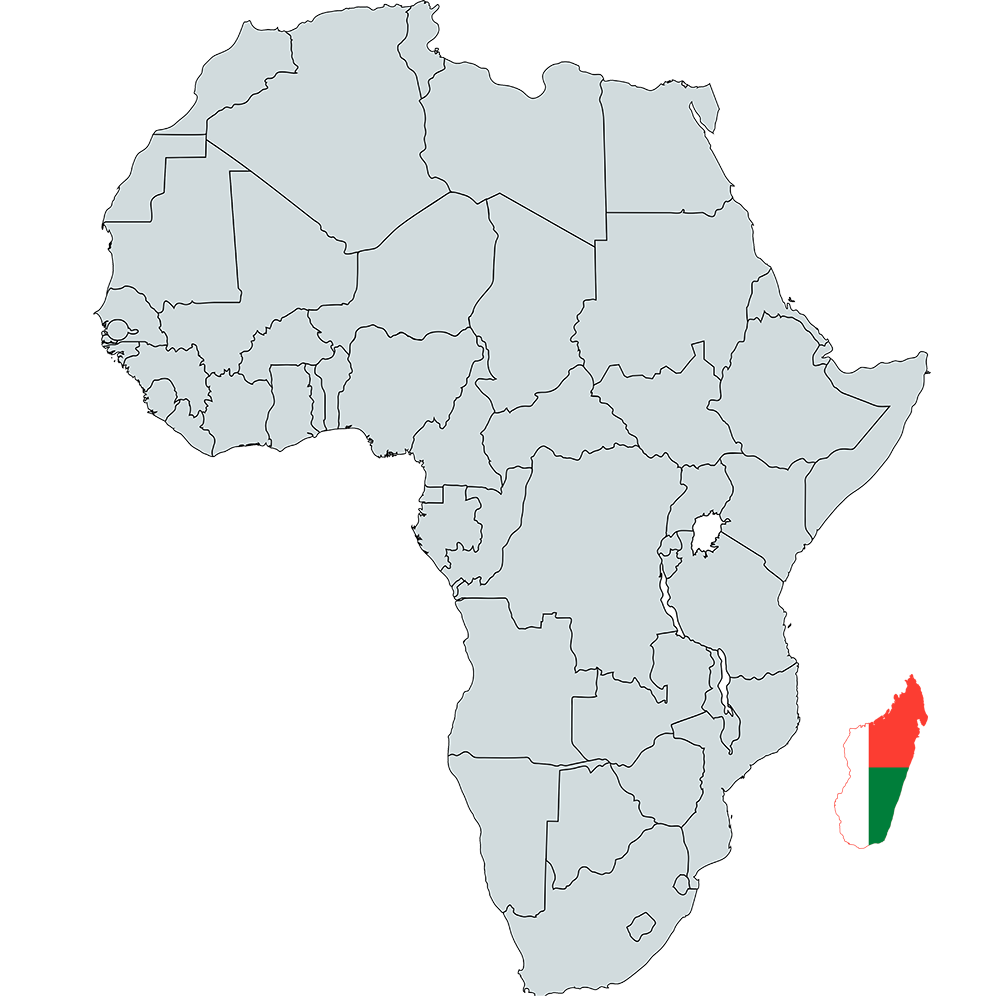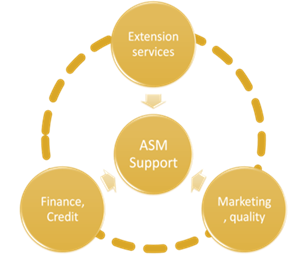
Madagascar ASM Profile Political Economy & Strategic Standpoints | Social and Environmental Factors | Local linkages | ASM Sites in Madagascar
Initially, Madagascar was not a mining-oriented country. Now the mining industry is gaining traction particularly through the production and export of a variety of chemical and metallurgical grade chromite ore and industrial mineral commodities. The mining sector attracts 40% of all FDI in the country and represents 30% of all exportations and 2.12% of GDP according t0 the Chamber of Mines. However, despite the variety in the sector, mining in Madagascar suffered a sharp decline due to a 2009 Coup.
ASM sites vary from mangrove/marine in the case of Antetezambato/Ambanja to terrestrial and from gold to different gemstones. Given Madagascar’s geological formation, gold is found within the country in the form of veins or sedimentary deposits following the erosion of mineral-rich bedrock. Madagascar’s gold deposits are classified broadly into two categories, primary and secondary deposits. Although sapphires and other gemstones have been known to exist in Madagascar since the 16th century, widespread mining is a relatively recent phenomenon.
Artisanal Mining has a long history in Madagascar with an estimated 500 000 miners involved in ASM and 350 000 specifically in gold mining, a total estimate brings ASM numbers at 1 million. Since Madagascar enacted the 2005 Mining Code, low-cost licensing models have been applied this resulted in a rise in formalization. Between 2004 and 2007, 1,383 of 1,500 gold panners in the Commune of Antanimbary had obtained permits (USAID, 2010). In Madagascar the issue of child labor is widespread especially for gemstones mining. Despite inefficiency in production, 40% of the Sapphires produced globally originate from Madagascar’s mines. Annual gold production is estimated at 15 tonnes. One of the challenges with the activity result from the location of most of the mines which overlap with protected areas posing a major biodiversity challenge.
Madagascar is considered as a biodiversity hotspot, hosting a remarkable number of endemic animal and plant species while artisanal mining is one of the most important sources of mercury release. The rise in ASM coincided with a series of three major political crises, over the last two decades making any form of control or monitoring even more challenging. This resulted in the vast majority of gems exported and traded from Madagascar informal virtually all the country’s $400 million worth of gemstones are still exported illegally (IIED, 2002).
Country Mining Vision Status
CMV Processes Underway.
Policies, Laws and Regulations Currently in Effect
Mining code 2005, (Revised in 2015)
ASM Associations or Cooperatives
NONE
ASM Definition Criterion
Mechanisation; number of miners; size of operation; Depth of mine
ASM Licensing
Artisanal: YES
Small Scale Mining: YES
ASM Minerals or Metals Exploited
Precious Metals Gold, Titanium
Base Metals Nickel, Chromium, Copper
Precious Stones Cobalt, Ilmenite, Rutile, Mica, Quartz, Salt, Graphite, Zirconium, Uranium
Development Minerals Gemstones Rare Earths, Marble
Mining Code Provisions for Women in ASM
No provisions or mentions of Women in the Mining code
Mineral Policy of Madagascar:
Mineral Policy of Madagascar:
Issue: lack of stability and biodiversity loss due to mining activities
Policy Objective: The primary goal of the Madagascar mining code is to improve the industry's results
Policy Statements:
I. Provide incentives for the local communities to support local production and creation of value from these minerals.
II. Ensure environmental conservation.
Policy Environment:
Madagascar has recently emerged from an extended political crisis. A newly elected president in 2013 put an end to the four-year transition period since the unconstitutional change of Government in March 2009, which saw the withdrawal of all donor support. Madagascar’s mining policy strives for more value added and linkages in the mining sector. Due to the country’s rich biodiversity, attention is particularly given to environmental impacts from mining activities. Land ownership and customary land ownership in particular pose some challenges in ASM. The national economy is not greatly diversified and is concentrated in several sectors and geographic regions. Recent changes in Madagascar’s Mining Code (2005) sought to increase formalization of ASM through substantial reductions in license and permitting fees.
Children perform dangerous task particularly in mining of sapphires although Madagascar has ratified all key international conventions concerning child labor. However, gaps exist in Madagascar’s legal framework to effectively reduce and eradicate child labor.
ASM SUPPORT TRIANGLE

Finance and credit
No official financing or credit programs available to miners.
Extension services - a phased approach to integration and capacity-building
The IGM (Institut de Gemmologie de Madagascar/ Institute of Gemology of Madagascar) provides courses and trained 34 gemologists, 280 lapidaries and 1500 “hand miners”. A custom Jewelry branch was created, encouraging handmade jewelry making and trade.
The Madagascar colored gemstones project aims to legalize the gem trade and create conditions that will end smuggling and other illegal activity by introducing a 2% royalties tax. Since beneficiation is part of the project, the 2% tax is waived for stones polished in the country.
Marketing and quality
Gemology and Lapidary projects for Women in South West Madagascar were created. The initiatives promote stone cutting and polishing for jewelry making which helps develop and enhance the value chain for ethical jewelry.

